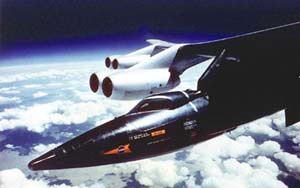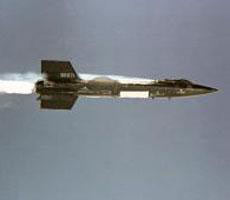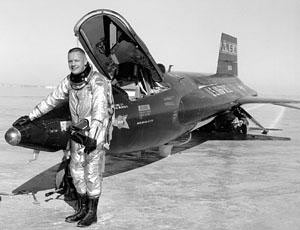|
 An X-15 rocket plane secured to the wing of a B-52 just before being released. |
SHIRLEY GRIFFITH: EXPLOATIONS -- a program in Special English by the Voice of America.
(MUSIC)
Today, Doug Johnson and Frank Oliver tell about the first airplane that flew out of the Earth's atmosphere. It was designed to test equipment and conditions for future space flights. The plane was called the X-15.
DOUG JOHNSON: The pilot of the huge B-52 bomber plane pushes a button. From under the plane's right wing, the black sharp-nosed X-15 drops free. It is eleven-and-one-half kilometers above the Earth.
Pilot Scott Crossfield is in the X-15's only seat. When he is clear of the B-52, he starts the X-15's rocket engine. And so begins the first powered flight of the experimental plane designed to take man to the edge of space.
FRANK OLIVER: The X-15 flies high over the sandy wasteland of California's Mojave Desert. Up, up it flies. After three minutes, its fuel has burned up. It is flying about 2,000 kilometers an hour.
Scott Crossfield's voice tightens. His breathing becomes harder as the plane pushes against the atmosphere. At that speed, the pressure is three times the force of gravity.
Then the X-15 pushes over the top of its flight path. It settles into a long, powerless slide toward the landing field at Edwards Air Force Base.
Designers of the X-15 have warned Crossfield about the landing. They say it will be like driving a race car toward a brick wall at 160 kilometers an hour, hitting the brakes, and stopping less than a meter from the wall. Crossfield lands the plane without any problem. His success shows, as one newspaper reports, that "The United States has men to match its rockets. "
(MUSIC)
DOUG JOHNSON: That first flight of the X-15 took place in September, 1959. But the story began in the 1940s with the X series of experimental aircraft.
The first plane ever to fly faster than the speed of sound was the X-1 in 1947. United States government agencies and America's airplane industry realized then that it was possible to build an even faster plane. It would reach hypersonic speeds -- five times the speed of sound.
The first proposal for this new research vehicle, the X-15, was made in 1954. The space agency, Air Force and Navy jointly supported the program. They wanted a plane that could test conditions for future flights into space.
FRANK OLIVER: The project moved quickly. The North American Aviation company won the competition to design and build the plane. The design would be part aircraft and part spacecraft. The company took less than four years to produce three X-15s.
The planes were not big. They were just 15 meters long with wings less than seven meters across. They were designed to fly at speeds up to 6,400 kilometers an hour. They were designed to reach heights of 80 kilometers. Their purpose was to explore some of the problems of manned flight, during short periods, in lower space. No one had ever done that before.
DOUG JOHNSON: The X-15 project had four major goals. It would test flight conditions at the edge of Earth's atmosphere. It would leave the atmosphere briefly, then return, testing the effects of the extreme heat of re-entry. It would provide information on the controls needed in the near weightless environment of lower space. And it would answer a very important question: How would humans react to space flight?
FRANK OLIVER: The X-15 was a new idea. And it was built with new methods. It was covered in a new material called "inconel x." The material was a mixture of the metals nickel and chromium. It would protect the plane from high temperatures.
There were new designs for the plane's rocket engine, landing equipment and the small rockets needed to move it in space. There was a new system of liquid nitrogen to keep the pilot cool and to resist the crushing force of gravity at high speeds. And there was a new fuel, a mixture of liquid ammonia and liquid oxygen.
(MUSIC)
DOUG JOHNSON: The X-15 was never designed to go into orbit. Nor could it take off from the ground. It was carried into the air by a B-52 bomber. The big B-52 carried the small X-15 under its wing. It looked a little like a mother whale swimming with its baby.
At about 15,000 meters, the B-52 released the X-15. After a few seconds, when the X-15 was safely away, the pilot started its rocket engine. The X-15 flew upward with unbelievable power.
|
 X-15 in flight. |
Once the real flight began, the pilot had to remember everything he learned. He had to work quickly and exactly. All his movements were made against a force that could reach six times the power of gravity. He had to struggle to reach forward for the controls while being pushed back hard in his seat.
A delay of even one second could affect the information being collected. It could change the plane's path just enough to destroy the pilot's chance of a safe landing.
DOUG JOHNSON: The X-15 set height and speed records greater than those expected. The number three plane climbed more than 107 kilometers above the Earth. The number two plane flew 7,232 kilometers an hour. That was more than seven times the speed of sound.
The X-15 was the first major investment by the United States in manned space flight technology. Much of what was learned from its flights speeded up the development of the space program.
FRANK OLIVER: The X-15 tested materials for space vehicles. It tested spacesuits worn later by America's astronauts. It tested instruments for controlling a vehicle in the weightlessness of space. And it proved that experienced pilots had the skills necessary to fly in space.
Twelve military and civilian test pilots flew the X-15s. A few became astronauts.
The X-15 program lasted about ten years. There were about 200 flights. Some of the flights carried scientific experiments. One was a container on the end of the wing. It gathered dust and tiny meteoroids from the edge of space. Another was a set of special instruments that helped measure the effects of the sun's radiation on the outside of the aircraft.
DOUG JOHNSON: The only tragedy connected with the X-15 program happened in 1967. The pilot was Michael Adams of the United States Air Force. It was his seventh X-15 flight.
Everything, at first, appeared to be normal. The plane reached a height of eight kilometers. It was flying more than five times the speed of sound. Then, during a test of the wings, the plane moved sharply off its flight path. It dove toward Earth at great speed, spinning rapidly out of control. Atmospheric pressure was too great for the plane. It broke apart. The pilot did not survive.
(MUSIC)
FRANK OLIVER: The X-15 made its last flight in December 1968. NASA needed money for its other projects. It decided to end the X-15 program. Many space experts disagreed with the decision. They felt the X-15 could have continued to provide new information about aviation and space.
|
 Pilot Neil Armstrong next to an X-15. |
On the floor below these aircraft are three spacecraft command ships. One of them, the Apollo-11, traveled to the moon just seven months after the last X-15 flight. It carried the man who became the first human to step on the moon, Neil Armstrong, a former X-15 pilot.
(MUSIC)
SHIRLEY GRIFFITH: This Special English program was written by Marilyn Rice Christiano. Your narrators were Doug Johnson and Frank Oliver. Join us again next week for another EXPLORATIONS program on the Voice of America.
nickel: a chemical element.Nickel is a hard silver-white metal used in making some types of steel and other alloys. 镍
chromium: a chemical element.Chromium is a hard grey metal that shines brightly when polished and is often used to cover other metals in order to prevent them from rusting. 铬
ammonia: a colourless gas with a strong smell; a clear liquid containing ammonia, used as a cleaning substance 氨
meteoroid: 流星体
6 astronauts train for eventual Mars mission
Shuttle Discovery launches mission to space station
Space shuttle Atlantis returns to Earth
(来源:VOA 编辑:陈丹妮)
